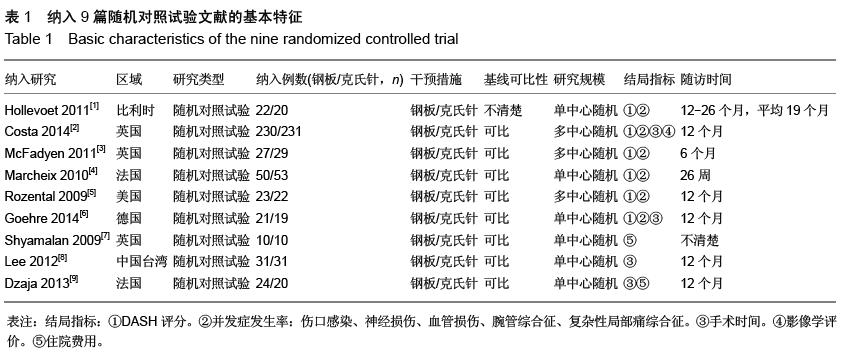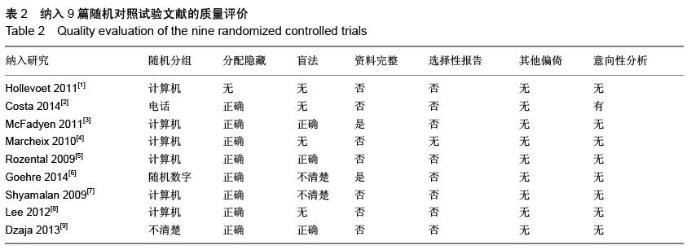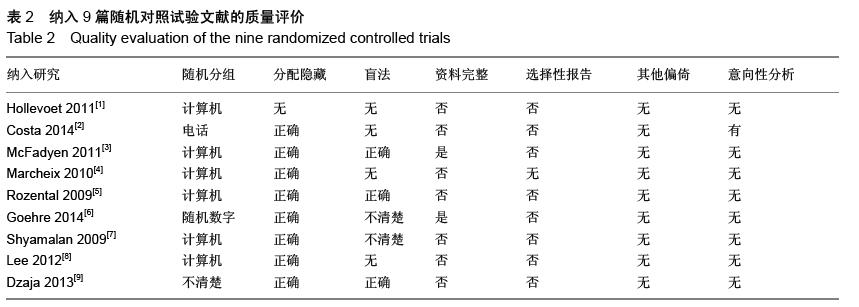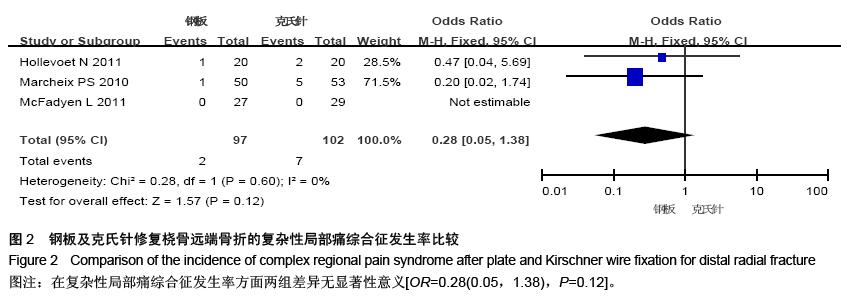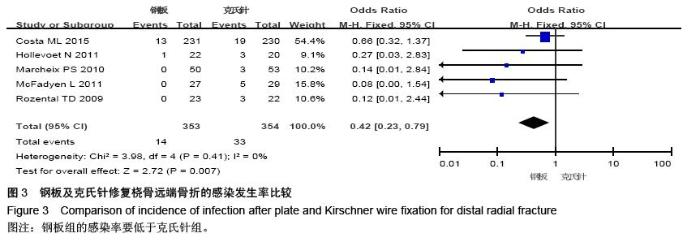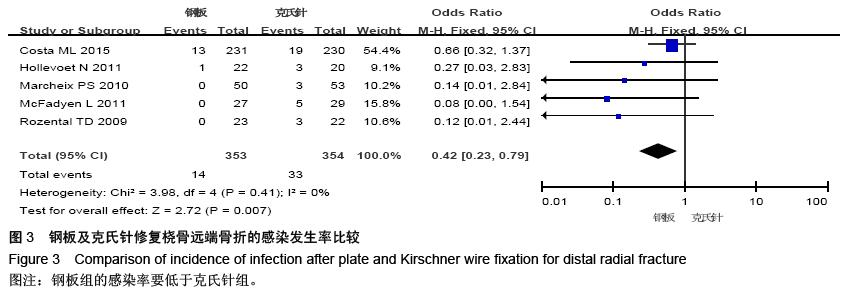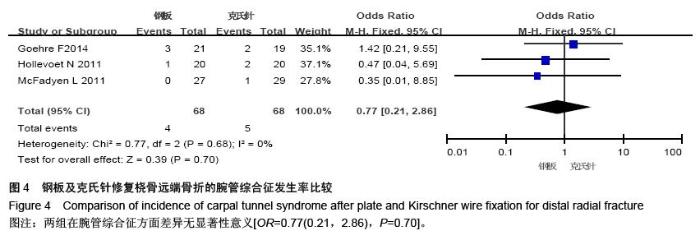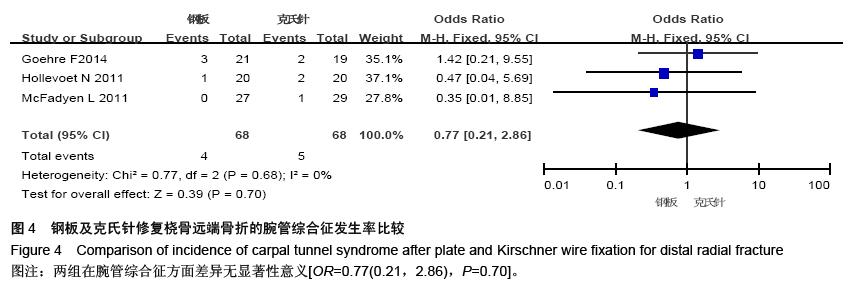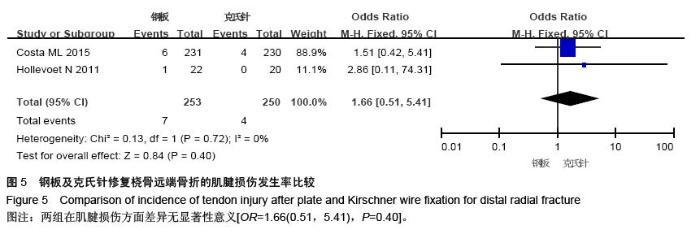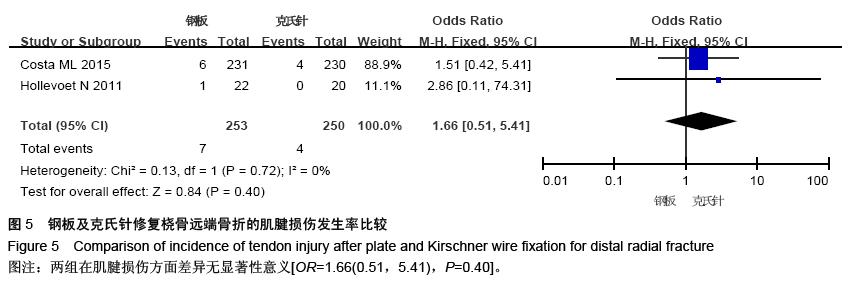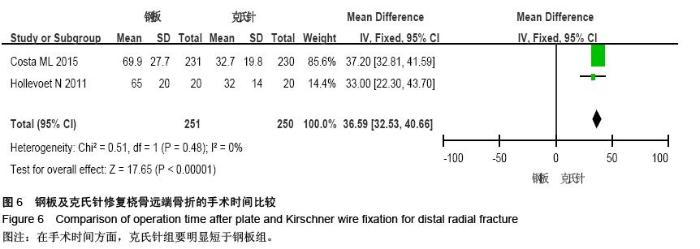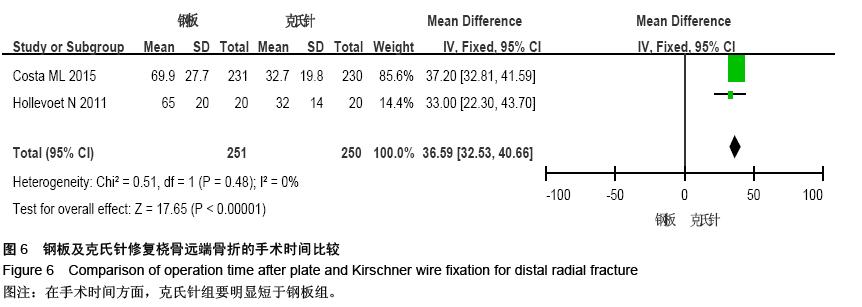| [1] Hollevoet N, Vanhoutie T, Vanhove W,et al. Percutaneous K-wire fixation versus palmar plating with locking screws for Colles' fractures. Acta Orthop Belg. 2011;77(2): 180-187.[2] Costa ML, Achten J, Parsons NR, et al. Percutaneous fixation with Kirschner wires versus volar locking plate fixation in adults with dorsally displaced fracture of distal radius: randomised controlled trial. BMJ. 2014; 349: g4807.[3] McFadyen I, Field J, McCann P, et al. Should unstable extra-articular distal radial fractures be treated with fixed-angle volar-locked plates or percutaneous Kirschner wires? A prospective randomised controlled trial. Injury. 2011;42(2): 162-166.[4] Marcheix PS, Dotzis A, Benkö PE, et al. Extension fractures of the distal radius in patients older than 50: a prospective randomized study comparing fixation using mixed pins or a palmar fixed-angle plate. J Hand Surg Eur. 2010;35(8): 646-651.[5] Rozental TD,Blazar PE,Franko OI, et al. Functional outcomes for unstable distal radial fractures treated with open reduction and internal fixation or closed reduction and percutaneous fixation. A prospective randomized trial. J Bone Joint Surg Am. 2009;91(8): 1837-1846.[6] Goehre F,Otto W,Schwan S,et al. Comparison of palmar fixed-angle plate fixation with K-wire fixation of distal radius fractures (AO A2, A3, C1) in elderly patients. J Hand Surg Eur. 2014;39(3): 249-257.[7] Shyamalan G,Theokli C,Pearse Y, et al. Volar locking plates versus Kirschner wires for distal radial fractures--a cost analysis study. Injury. 2009;40(12): 1279-1281.[8] Lee YS,Wei TY,Cheng YC, et al. A comparative study of Colles' fractures in patients between fifty and seventy years of age: percutaneous K-wiring versus volar locking plating. Int Orthop. 2012;36(4): 789-794.[9] Dzaja I, MacDermid JC,Roth J, et al. Functional outcomes and cost estimation for extra-articular and simple intra-articular distal radius fractures treated with open reduction and internal fixation versus closed reduction and percutaneous Kirschner wire fixation. Can J Surg. 2013;56(6): 378-384.[10] Asadollahi S,Keith PP. Flexor tendon injuries following plate fixation of distal radius fractures: a systematic review of the literature, J Orthop Traumatol. 2013; 14(4): 227-234.[11] Shauver MJ, Yin H, Banerjee M, et al. Current and future national costs to medicare for the treatment of distal radius fracture in the elderly. J Hand Surg Am. 2011;36:1282-1287.[12] Sammer DM, Shah HM, Shauver MJ. The effect of ulnar styloid fractures on patient-rated outcomes after volar locking plating of distal radius fractures. J Hand Surg Am. 2015.[13] Brogren E, Wagner P, Petranek M. Distal Radius Malunion Increases Risk of Persistent Disability 2 Years After Fracture: A Prospective Cohort Study, Clin Orthop Relat Res. 2013; 471(5): 1691-1697.[14] Costa ML, Achten J, Plant C, et al. UK DRAFFT: a randomised controlled trial of percutaneous fixation with Kirschner wires versus volar locking-plate fixation in the treatment of adult patients with a dorsally displaced fracture of the distal radius. Health Technol Assess. 2015;19(17): 1-124.[15] Costa ML, Achten J, Parson NR,et al. UK DRAFFT - a randomised controlled trial of percutaneous fixation with kirschner wires versus volar locking-plate fixation in the treatment of adult patients with a dorsally displaced fracture of the distal radius. BMC Musculoskelet Disord. 2011; 12: 201.[16] 周海涛,项舟,胡炜,等. T形钢板内固定结合外固定架治疗不稳定性桡骨远端骨折[J].中华创伤骨科杂志, 2006, 8(3):216-220.[17] Kim JH, Lee HJ, Kim J, et al.Korean Type Distal Radius Anatomical Volar Plate System:A Preliminary Report, Clin Orthop Surg. 2014; 6(3): 258-266.[18] American Academy of Orthopaedic Surgeons. The treatment of distal radius fractures: guideline and evidence report. 2009. [accessed 2013 Oct.18]. Available: http://www.aaos.org/uploadedFiles/PreProduction/Quality/Guidelines_and_Reviews/Distal%20Radius%20Fractures.pdf[19] Hollevoet N, Vanhoutie T, Vanhove W, et al. Percutaneous K-wire fixation versus palmar plating with locking screws for Colles’ fractures. Acta Orthop Belg. 2011;77:180-187.[20] Øyen J,Diamantopoulos AP,Haugeberg G. Mortality after Distal Radius Fracture in Men and Women Aged 50 Years and Older in Southern Norway, PLoS One. 2014; 9(11): e112098.[21] Dhainaut A, Hoff M, Syversen U,et al.Cortical Hand Bone Porosity and Its Association with Distal Radius Fracture in Middle Aged and Elderly Women. PLoS One. 2013; 8(7): e68405. [22] Liu X, Wu WD, Fang YF, et al. Biomechanical Comparison of Osteoporotic Distal Radius Fractures Fixed by Distal Locking Screws with Different Length. PLoS One. 2014; 9(7): e103371.[23] Diamantopoulos AP, Rohde G, Johnsrud I, et al. The Epidemiology of Low-and High-Energy Distal Radius Fracture in Middle-Aged and Elderly Men and Women in Southern Norway. PLoS One. 2012; 7(8): e43367.[24] Walenkamp MM, Goslings JC, Beumer A, et al. Surgery versus conservative treatment in patients with type A distal radius fractures, a randomized controlled trial. BMC Musculoskelet Disord. 2014; 15: 90.[25] Chen YX, Zheng X, Shi HF, et al. Will the untreated ulnar styloid fracture influence the outcome of unstable distal radial fracture treated with external fixation when the distal radioulnar joint is stable. BMC Musculoskelet Disord. 2013; 14: 186.[26] Synn AJ, Makhni EC, Makhni MC,et al.Distal Radius Fractures in Older Patients: Is Anatomic Reduction Necessary? Clin Orthop Relat Res. 2009;467(6): 1612-1620.[27] Hull P,Baraza N,Gohil M, et al. Volar locking plates versus K-wire fixation of dorsally displaced distal radius fractures--a functional outcome study. J Trauma. 2011;70(6): E125-128.[28] Martineau D, Shorez J, Beran C, et al. Biomechanical Performance of Variable and Fixed Angle Locked Volar Plates for the Dorsally Comminuted Distal Radius. Iowa Orthop J. 2014; 34:123-128. [29] 袁义伦,苏建敏,侯江伟,等.桡骨远端骨折钢板内固定与外固定架固定疗效的比较[J].中国医药指南,2011,9(13): 242-243.[30] Heo YM, Kim SB, Yi JW,et al.Evaluation of Associated Carpal Bone Fractures in Distal Radial Fractures. Clin Orthop Surg. 2013; 5(2): 98-104.[31] Mackay BJ, Montero N, Paksima N, et al. Outcomes Following Operative Treatment of open Fractures of the Distal Radius: A Case Control Study. Iowa Orthop J. 2013; 33: 12-18. |

